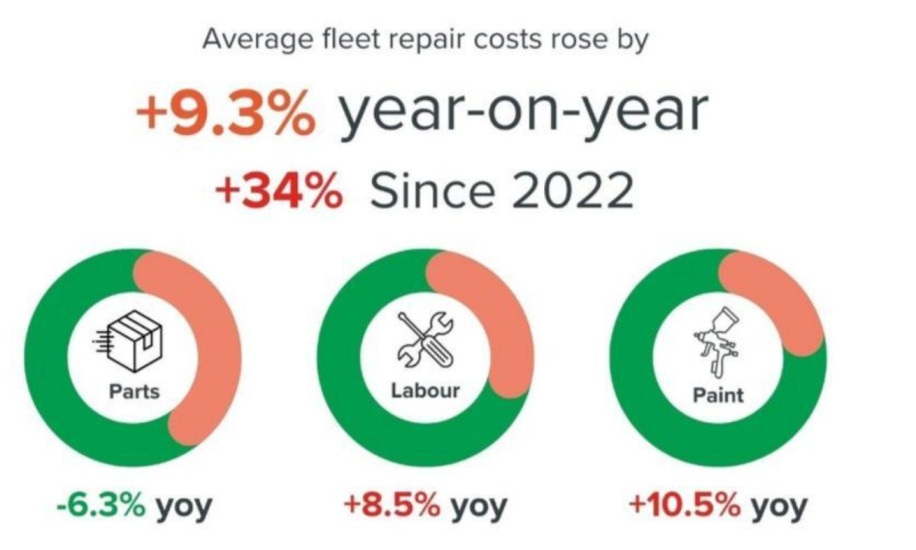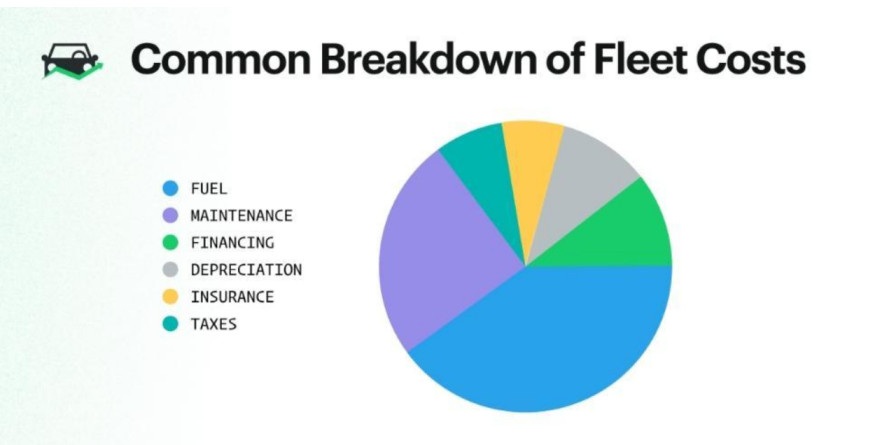What is Fleet Lifecycle Management? A Brief Guide
Fleet lifecycle management can be a challenging task for any manager. Learn what it is and how Itefy helps you handle your fleet from start to end like a pro.
In this article:
- What is Fleet Lifecycle Management?
- Factors that Impact a Fleet’s Lifecycle
- 1. Vehicle Type and Specifications
- 2. Usage
- 3. Maintenance Practices
- 4. Regulatory Changes
- How Does Itefy Help With Fleet Lifecycle Management?
- 1. Fleet Asset Tracking and Utilization
- 2. Optimized Maintenance Scheduling and Cost Reduction
- 3. Compliance and Risk Management
- 4. Data-Driven Fleet Disposal and Replacement Planning
- Manage Your Fleet Like a Pro With Itefy

Fleet lifecycle management is a critical responsibility of any fleet manager because it allows them to gain maximum value from their investments.
It is indisputable that fleet vehicles age with time. Their fuel efficiency decreases, they need more repairs and longer maintenance sessions, and, on top of everything, their resale value declines significantly, too. For a fleet manager, timing is of the essence—they should know when to get rid of a vehicle before its operating bill piles up.
Doing it manually is almost impossible today, which is why you need a comprehensive fleet lifecycle management system. This guide will help you understand what a fleet lifecycle management system is, how it works, and how to use it to manage your vehicles like a pro.
What is Fleet Lifecycle Management?
A vehicle’s life starts when it is purchased and ends when it is sold. Fleet lifecycle management means dealing with these two and everything that comes in between: usage, maintenance, compliance requirements, data analysis, and more.
A major responsibility of any fleet manager is to ensure that the vehicles operate at their highest potential and don't become a financial burden on the organization. Many managers use advanced software to strategically plan fleet usage so that each vehicle provides maximum benefit. One example is ensuring that each vehicle's fuel average isn't below the number recommended by the manufacturer and industry standards.
Factors that Impact a Fleet’s Lifecycle
The lifecycle of a vehicle depends on several factors that impact its performance, longevity, and total cost of ownership. Understanding these factors means you can make informed decisions when acquiring vehicles and get the most value when selling them.
1. Vehicle Type and Specifications
Not all vehicles are created the same way; some are built ruggedly, while others are meant to be used in normal conditions. The make, model, and intended purpose of a vehicle play a key role in deciding how long it will last. Heavy-duty trucks are meant to be used by fleets that cover long distances and carry excessive weight. On the contrary, lightweight vehicles are designed for smaller distances, which is why they also require fewer maintenance sessions.
2. Usage
Mileage, load capacity, terrain, and driving habits are important factors in a vehicle’s lifecycle. Vehicles used in harsh environments where they go on bumpy terrains wear out more quickly than the ones running on smooth city roads. Similarly, the vehicles getting loaded more often and with heavier equipment age much faster than their lightweight peers. Always stick to the manufacturer's guidelines regarding terrains and cargo to extend the vehicle’s life.
3. Maintenance Practices
Not maintaining your vehicles at regular intervals means putting them at risk of losing value and performance. When you have a consistent maintenance schedule aligned with fleet usage, you experience fewer breakdowns and better fuel efficiency. Ultimately, quality maintenance practices save you a lot of money.

Source: SoppandSopp
Pro Tip: Read our comprehensive truck maintenance checklist and keep your fleet running smoothly throughout the year.
4. Regulatory Changes
The regulatory frameworks around vehicles keep changing, which makes it crucial to stay updated. There have been several tweaks to emission laws in the US in recent years. For instance, the Biden administration tightened the regulations around auto emissions in 2024, but the Trump administration has recently announced to roll them back.
Similarly, safety standards and licensing requirements are also revised as conditions change. This means your fleet might be subject to different regulations in different years.
The fleet that is compliant today might not be compliant tomorrow, and vice versa. You should be ready to retire vehicles that are not compliant at the best possible prices.
Note: Learn about the broader impact of Trump tariffs on equipment prices and strategize your fleet management accordingly.
How Does Itefy Help With Fleet Lifecycle Management?
Managing a fleet requires more than just tracking mileage and scheduling maintenance. A comprehensive fleet lifecycle management system should provide deep insights into every stage of the vehicle's life. It helps managers make data-driven decisions to maximize efficiency and reduce costs. This is where Itefy excels and changes the way you manage your fleet.
Let's discover how Itefy simplifies fleet lifecycle management for businesses.
1. Fleet Asset Tracking and Utilization
One of the most crucial aspects of fleet lifecycle management is tracking vehicle usage and ensuring assets are optimally used. Itefy is a centralized platform that lets fleet managers:
- Track engine hours and odometer readings to gauge wear and tear.
- Log and analyze vehicle usage data to ensure successful deployment.
- Assign vehicles to specific teams or projects and keep a record of responsibilities.
- Generate usage reports to identify underutilized assets and optimize fleet operations.
Itefy’s digital asset tracking helps you gain full visibility over your fleet. It ensures that vehicles are neither overworked nor left idle, which extends their lifespan and improves cost efficiency.
2. Optimized Maintenance Scheduling and Cost Reduction
Regular maintenance is essential for keeping fleet vehicles in top condition. However, manual tracking can lead to missed maintenance schedules, increased downtime, and costly repairs.

Source: Fleetio
With Itefy, fleet managers can proactively approach vehicle maintenance by:
- Automating maintenance reminders to ensure timely servicing.
- Setting up predictive maintenance schedules based on vehicle usage patterns and historical data.
- Receiving alerts for potential mechanical failures before they become critical.
- Maintaining a complete log of repairs and servicing for each vehicle to ensure compliance with manufacturer recommendations.
By leveraging these features, fleet managers can minimize unexpected breakdowns, extend the longevity of their vehicles, and significantly lower maintenance expenses.
3. Compliance and Risk Management
Fleet managers have to keep their fleet compliant with various regulations, including emission standards, safety inspections, and insurance policies.
Itefy simplifies compliance management by:
- Keeping track of licenses, permits, and insurance expirations.
- Sending automated alerts for renewal deadlines to prevent lapses.
- Storing compliance records for easy access during audits or inspections.
- Monitoring driver behavior, ensuring adherence to safety standards
- Tracking accident reports and implementing preventive measures based on historical data.
This proactive approach minimizes the risk of regulatory fines and keeps the fleet running smoothly.
4. Data-Driven Fleet Disposal and Replacement Planning
Knowing when to retire a fleet vehicle is crucial for maximizing return on investment (ROI). Holding onto a vehicle for too long can lead to higher maintenance costs and reduce resale value.
Itefy's fleet lifecycle management can help with:
- Data-driven insights that indicate the optimal time for vehicle replacement.
- Depreciation tracking to calculate resale value and ensure profitable disposal.
- Reports that help fleet managers compare vehicle performance and identify underperforming assets.
- Evaluating the cost-benefit ratio of keeping a vehicle versus replacing it with a newer, more efficient model.
- Providing historical maintenance and usage data to potential buyers, increasing resale value.
Manage Your Fleet Like a Pro With Itefy
Fleet lifecycle management is complicated and expensive, but you can make it much easier with Itefy's advanced software.
Our centralized system is admired by managers because of its efficiency and ease of use. It requires no advanced technical knowledge, as everything is just a click away and presented simply. From scheduling equipment usage to location tracking to accessing a cloud equipment database, Itefy can do everything.
Get in touch with us and let us change how you manage your fleet – at the best industry prices.
Frequently Asked Questions
-
Here are the most important fleet management KPIs every manager should measure:
Downtime and Maintenance: How often is a vehicle being maintained/repaired, and what are the downtimes it's suffering from?
Budgeting: Real-time cost monitoring to maximize profits.
Client Satisfaction: Are clients satisfied with the performance of the fleet?
Total Cost of Ownership (TCO): The total money spent on a vehicle throughout its lifecycle. -
Following are some of the major fleet lifecycle management challenges faced by managers:
Vehicle acquisition: The process of buying a new vehicle, considering its price, usage, future compliance, and more.
Vehicle maintenance: Regular maintenance sessions and the costs associated with them.
Regulatory compliance: Whether your current fleet is compliant with the regulations or needs to be modified/retired.
Fuel wastage: Knowing the average fuel consumption of the fleet and analyzing if it is efficient enough.
Data handling: Gathering and analyzing the data from the fleet management software and getting valuable insights from it. -
A fleet management tool organizes and efficiently manages the fleet. It provides real-time updates regarding each vehicle and the people assigned to its maintenance.
-
Acquiring and running a successful fleet requires significant investments in hundreds and thousands of dollars. Maintenance incurs continuous expenses to ensure the business doesn't face disruption. Fleet lifecycle management helps businesses maximize the potential of these investments and dispose of the vehicles at the right time.
-
Vehicle lifecycle management refers to handling a vehicle from its acquisition to disposal. It involves various stages, all finely tuned to ensure you get the maximum value from your investment.
